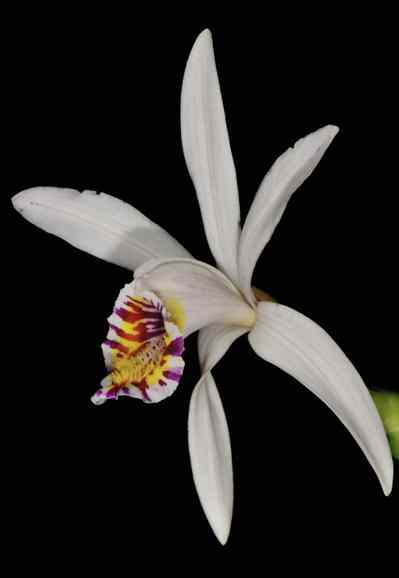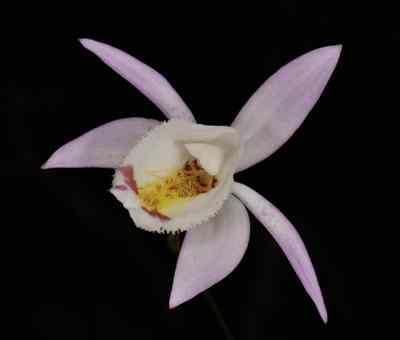The Plant
Epiphyte, pseudo-bulbs varying in shape at different stages of growth, generally cylindric to barrel shaped, its surface mottled with purplish brown, enveloped by loose brown fibers. Leaf in pairs, 6 to 15 cm long and 3 to 4 cm in width, narrowly elliptic-oblong, acute, narrowed to the petiole, base sheathed with bracts having nodular inflations. Leaf-less during flowering.
The Flower
Flowers solitary, erect, large, 5 to 6 cm across, rising from the base of the pseudo-bulb by a very short peduncle covered in a large spathaceous flower bract with broad emarginate apex, longer than the ovary. Sepals spreading, sub-equal, oblong to lanceolate, sub-acute, 7 nerved. Petals spreading, narrower than the sepals, of the same length or slightly shorter than latter, oblong, five to seven nerved. Lip broadly elliptic, three lobed, the basal part convolate round the column; the lateral lobes entire and narrower; the terminal broader, with sub-entire edges and broad apex. The disc with 5 to 7 fimbriate ridges. Column long and slightly curved, its apex winged. Pollinia elliptic.
Sepals and petals pure white, occasionally with streaks of dark brownish pink. The lip is white based with its interior marked with yellow and brownish pink streaks. The fimbriate ridges are yellow.

The Pursuit
A rare and threatened species of the region. Very rarely spotted in the natural habitats in the past decade. However, it is surprising to see many orchid scientists and researchers published its photographs in many articles. It amused me to know most of them had never been too long in the region. I had closely studied many photographs to find that the colouration and structure never matched the descriptions of King and Pantling. Later, I found that this species is growing in many nurseries of the region – one of the reasons of its disappearance from the natural habitats, and all those scientists had the privilege of documenting the plant and its flower from those nurseries. The species is a native to tropical forests and its translocation to higher altitude made it adopt another characteristics which was evident in all those photographs.
Hence, I decided to find it from its natural habitats itself. As it is a low altitude species and native to tropical valleys, the search was concentrated on the banks of river Teesta. However, I was not able to spot them from any of the places known to me. In the month of October, I was traveling in a service vehicle to another region in search of some species. A group of ladies were the co-passengers, returning to their homes after purchase in connection with Durga puja (a big festival of the region). As a practice, I always show my co-passengers drawings of orchids made by Pantling from my IPad. It had helped me a lot as many people had given me enough tips to find many species. I had shown the drawing of this species also. One of the ladies identified it and even narrated stories of collecting its flowers for the Durga puja (it flowers in the month of October/November, the season of Durga puja). She had explained to me about its location which is near to her maternal home. I noted down all the points for identifying the location from her talks. Next week, I started my journey to her village, where I luckily got some contacts. However, even after searching for three days we were not able to locate the tree or the plant. On the fourth day, as we were about to go to another site for search, we met the same lady in the village market. She is back in her home in connection with the Durga puja. My contacts were very well connected with her and made enquiries about the location of the tree. After getting maximum information, our small party of three went to the place she directed. All the three were climbing different trees to locate the plant. Finally, after a search of around four hours we found a small patch of plants, numbering 14, in full bloom. It was such an exciting moment to all of us. I was so lucky when the whole village was celebrating the Durga puja with local brew and drinks, my loyal contacts were happy to be with me in locating the plant. If we had waited for all the celebrations to be over, we would have found the flowers in a withered state only. With the help of those very kind friends I was able to produce this wonderful photograph with all the characteristics described by King and Pantling.
Later on, last year, I found one more habitat of this rare plant.

